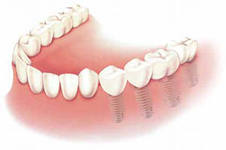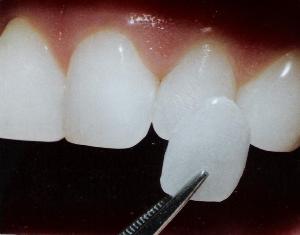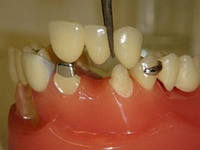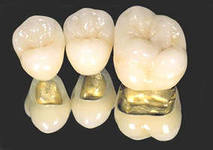Fixed dentures

Fixed dentures - these are prostheses that are worn constantly, because they are firmly fixed in the mouth. Modern prosthesis manufacturing technologies allow patients to make a choice in favor of a particular design.
Wearing fixed prostheses is most relevant for children, young and middle-aged people.
The advantage of fixed structures is their naturalness and high aesthetics. After installing the prosthesis, a person can lead a full-fledged lifestyle and not think about those problems that worried him before.
Non-removable prosthetics is one of the solutions for the absence of one or more teeth in the oral cavity.
Types of fixed dentures
Dentures may be temporary or permanent. Temporary structures include the so-called fixed dentures.
Types of permanent fixed dentures:

- Partial denture or microprosthesis of a tooth (veneers, inlays).
- Single tooth crowns.
- Bridge prostheses.
- Cantilever crowns.
- Dental implantation.
When choosing one or another method of prosthetics, the state of the dentofacial system plays a role.
Types of fixed prosthetics directly depend on the degree of damage to the teeth.
- Micro prosthetics is recommended for patients with incomplete tooth decay. The restored tooth will have the same color as healthy teeth. Tabs are used to eliminate large tooth defects. They are more aesthetic and stronger fillings. In this regard, tabs are very popular. If the part of the tooth visible to those around is damaged, then a vinyl plate is made on the front teeth to hide defects.
- Dental crowns are installed with partial tooth decay.
- Single crowns with a stump tab on a pin are made if only the root is left from the tooth.
- Bridge prostheses will help in the absence of one and with the loss of all teeth. Such a prosthesis is put in place of the missing tooth and rests on adjacent teeth, on which crowns are worn. Alternative to crowns on healthy teeth can be tabs, which also serve as a support. When using tabs, teeth do not have to grind. Now, using new technologies, dentures are made on gingival supports, which are attached to the teeth or gums in a more gentle way. Bridges on locks are very popular today. As well as prostheses fixed using composite materials.
- Cantilever structures are supported only at one end.
- Dental implants are the most advanced type of modern prosthetics. If only a removable prosthesis is indicated, then implantation is the best way out in this situation.
Which are better

Fixed structures can be made of silver-palladium alloy, plastic, flexite, ceramic or metal.
Plastic fixed dentures for restoration of teeth are used very rarely. At present, in orthodontics, the most popular material for prosthetics is cermet.
She completely replaced metal structures. The use of cermet allows you to bring the color of the prosthesis closer to the natural color of the patient’s teeth.
This material is characterized by lightness, durability, strength and durability. In some cases, ceramics without metal are used to make anterior and posterior teeth, so the cost of such a prosthesis is higher. This technology allows you to solve aesthetic problems.
Stamped and cast crowns, as well as fixed bridges made of metal, are highly durable and durable. The disadvantage of such designs is an unaesthetic appearance. Bridge prostheses on stamped metal crowns have an intermediate part fixed with solder. Solder can have a toxic effect.
Combined crowns combine plastic and metal. Plastic It makes the design aesthetics better, but has negative properties - it is able to absorb various odors and some substances. Plastic crowns not only darken over time, but also cause gum disease.

The thickness of the combined crown is more stamped, so when installing it is necessary to remove the nerve in order to avoid inflammation in the pulp of the tooth under the crown.
For cast crowns and bridges, plastic is used for fixed prosthetics (metal acryl) and ceramic (metal-ceramic).
Currently, if one tooth is missing, a fixed adhesive prosthesis can be made. Such an artificial tooth may be made of ceramic or plastic. The technique of manufacturing it is such that the prosthesis is held on adjacent teeth using micro-locks. These micro-locks can be glued to the abutment teeth or lowered into the prepared grooves on the abutment teeth and fixed using light-cured materials.
Orthopedic treatment with fixed prostheses For restoration of teeth can only be advised by the attending physician.
Care for fixed dentures
Careful hygienic care is required for fixed dentures and the oral cavity, because dentures can have gaps in which particles of food fall.
- Teeth and dentures should be cleaned at least twice a day with a toothbrush (not too hard) and toothpaste. As an additional means of cleaning, use dental floss, toothpicks and special brushes to clean the spaces between the teeth.
- Do not chew solid food, bite nuts or other solid foods.
- Use the products recommended by your dentist for oral care.
- After each meal, rinse your mouth with clean water or decoctions of herbs.
- Do not use metal needles or other sharp objects to clean the prosthesis.
Stages of manufacturing fixed prostheses
Before you make a fixed denture, you need to visit a dentist - orthodontist. The stages of manufacturing fixed prostheses - veneers and tabs differ in time and frequency of visits to the dentist, from the stages of manufacturing dental crowns and bridges.
To install the veneer or tabs on the first visit, the doctor makes an impression. During the second visit, a model of a tooth made of wax is tried on. Then the veneer is installed.
When installing crowns and bridges:
- If necessary, teeth are treated that need to be sharpened.
- Turning of supporting teeth.
- Taking a mold on which a denture will be created.
- Fitting, fitting and installation of the dental structure. At the same time, the closure of the teeth that make up the prosthesis with opposite teeth and the aesthetics of the structure are checked.If necessary, the design is corrected.
Installation
The installation scheme of the crowns is as follows: the nerve is removed and a ceramic or other insert is inserted into the cavity that formed, after which the tooth is grinded to the thickness of the future crown. On top of it, a manufactured crown is put on. On average, three visits to a doctor are required to install a metal-ceramic denture.
Both the dental crowns and the bridge prosthesis on the crowns are fixed on the prepared teeth using special cement.
